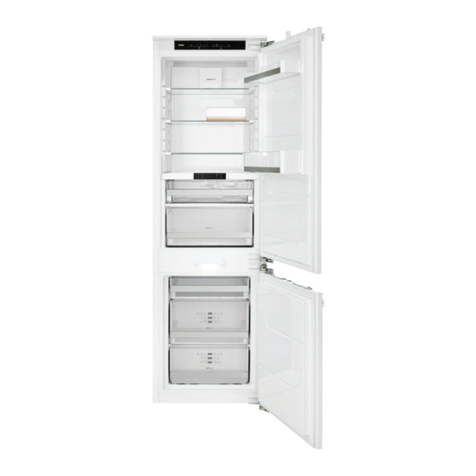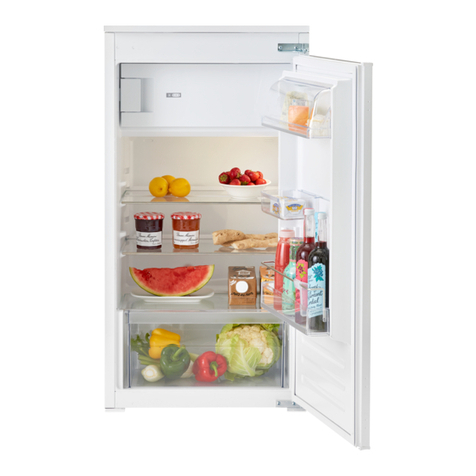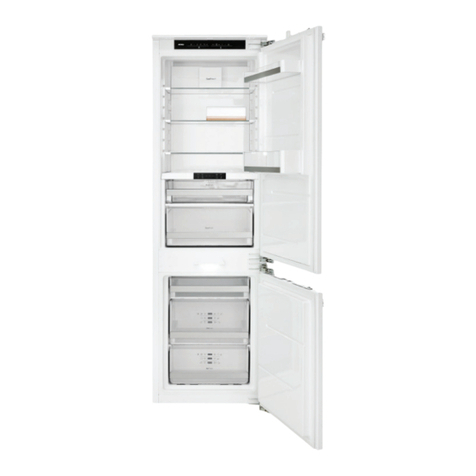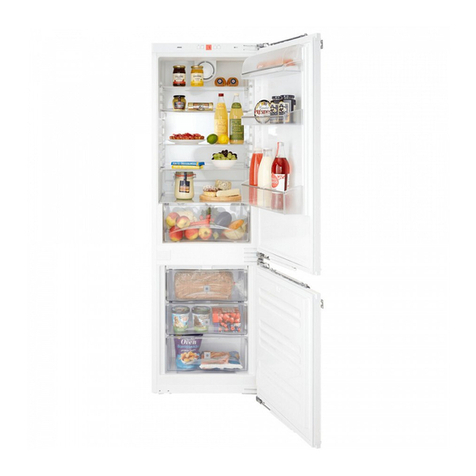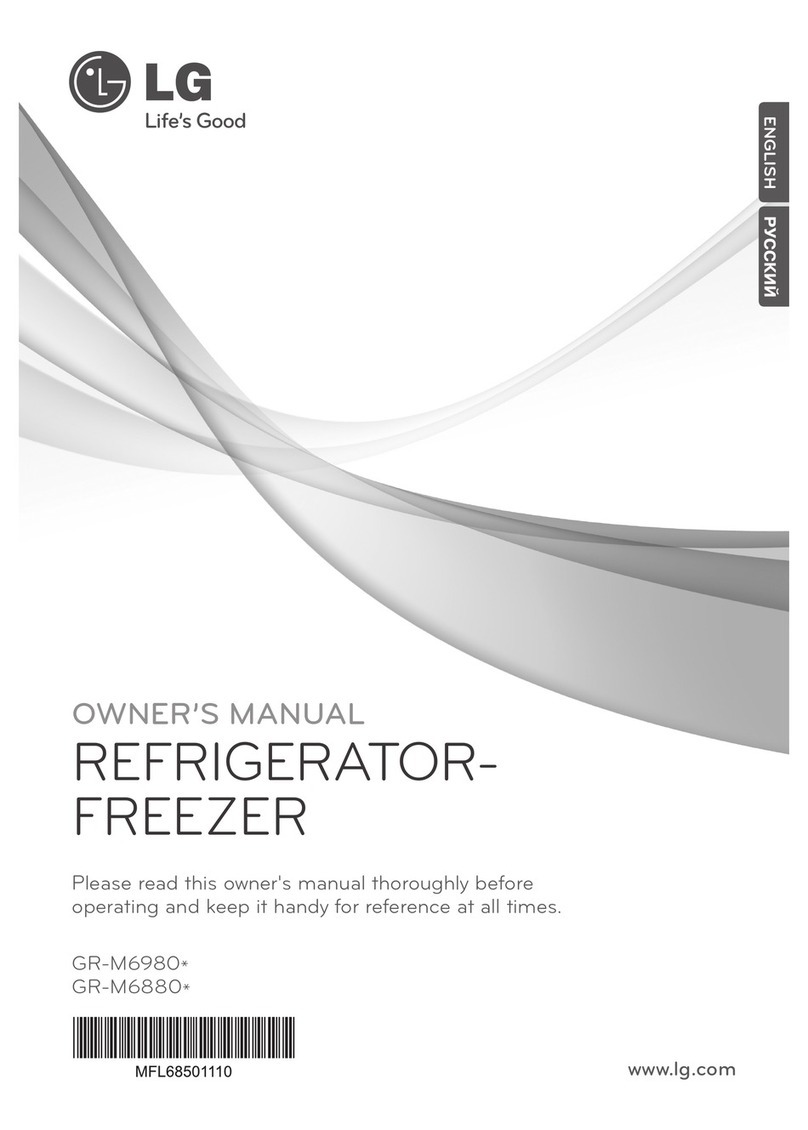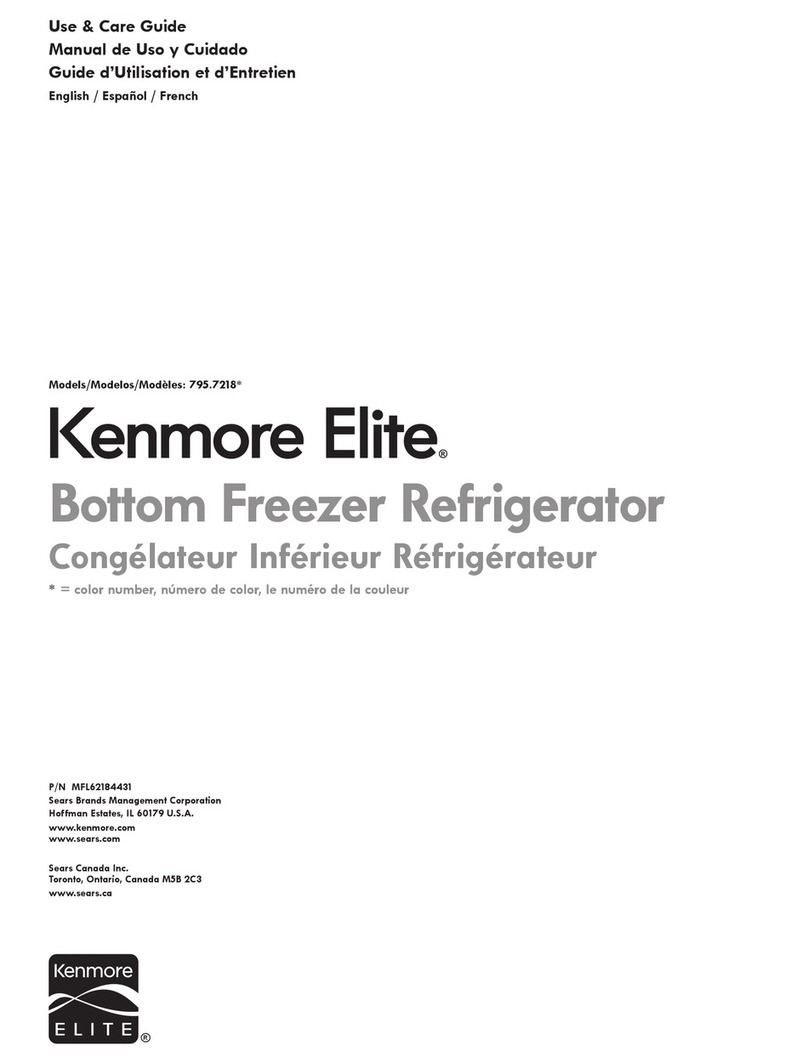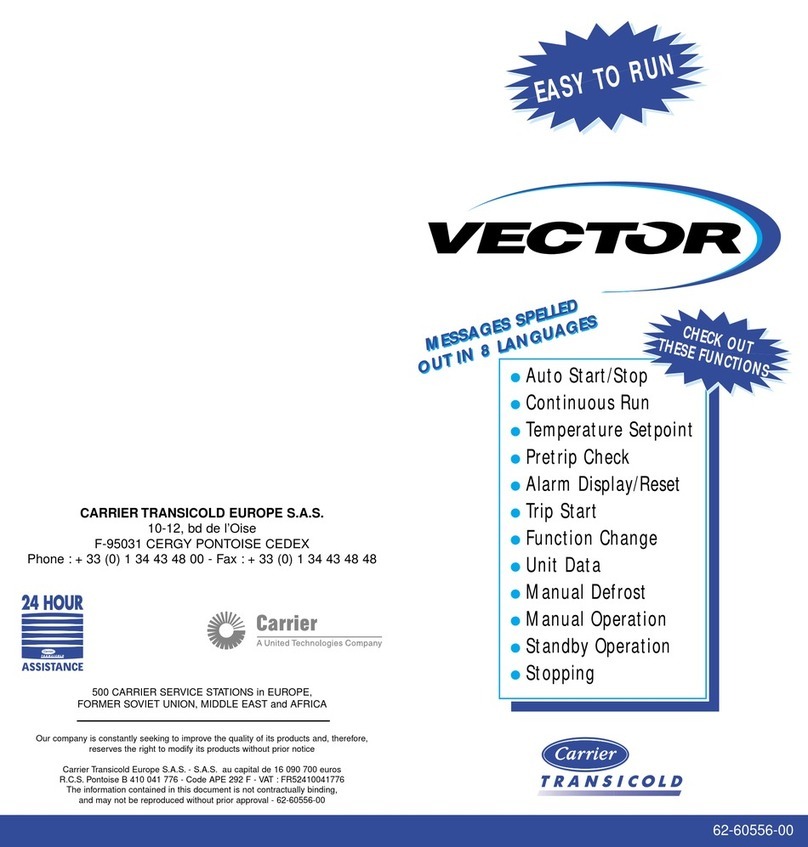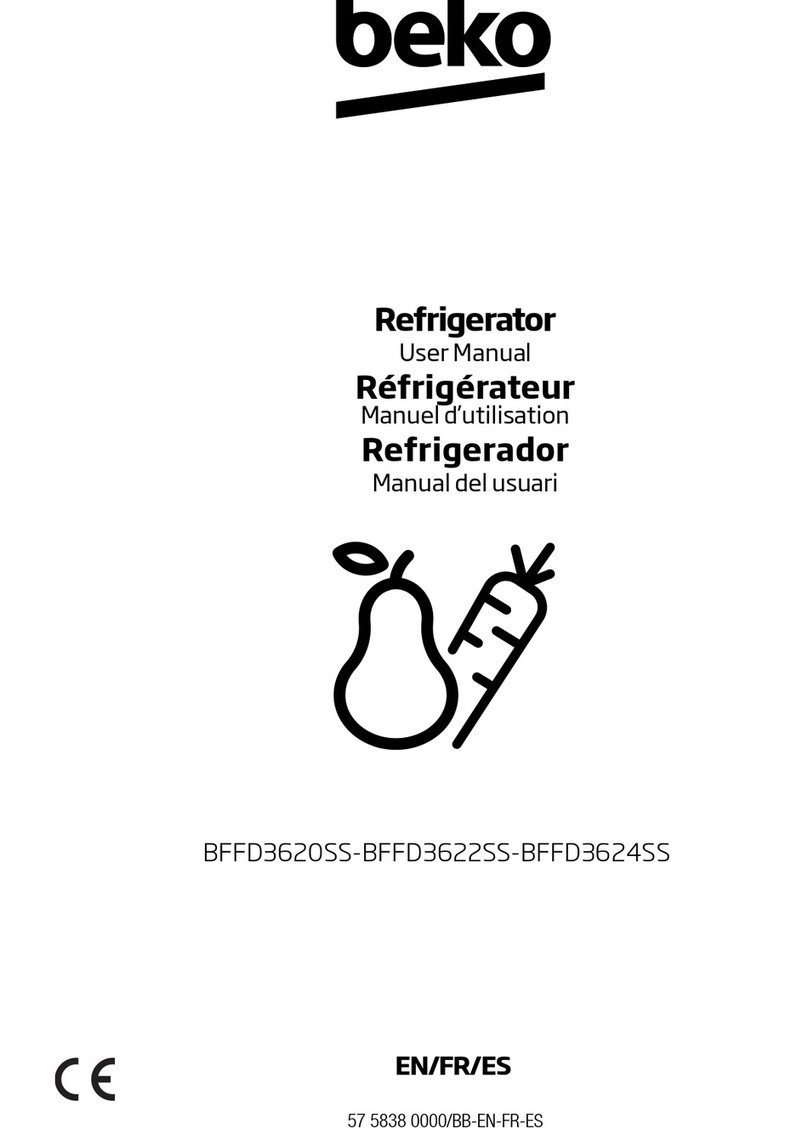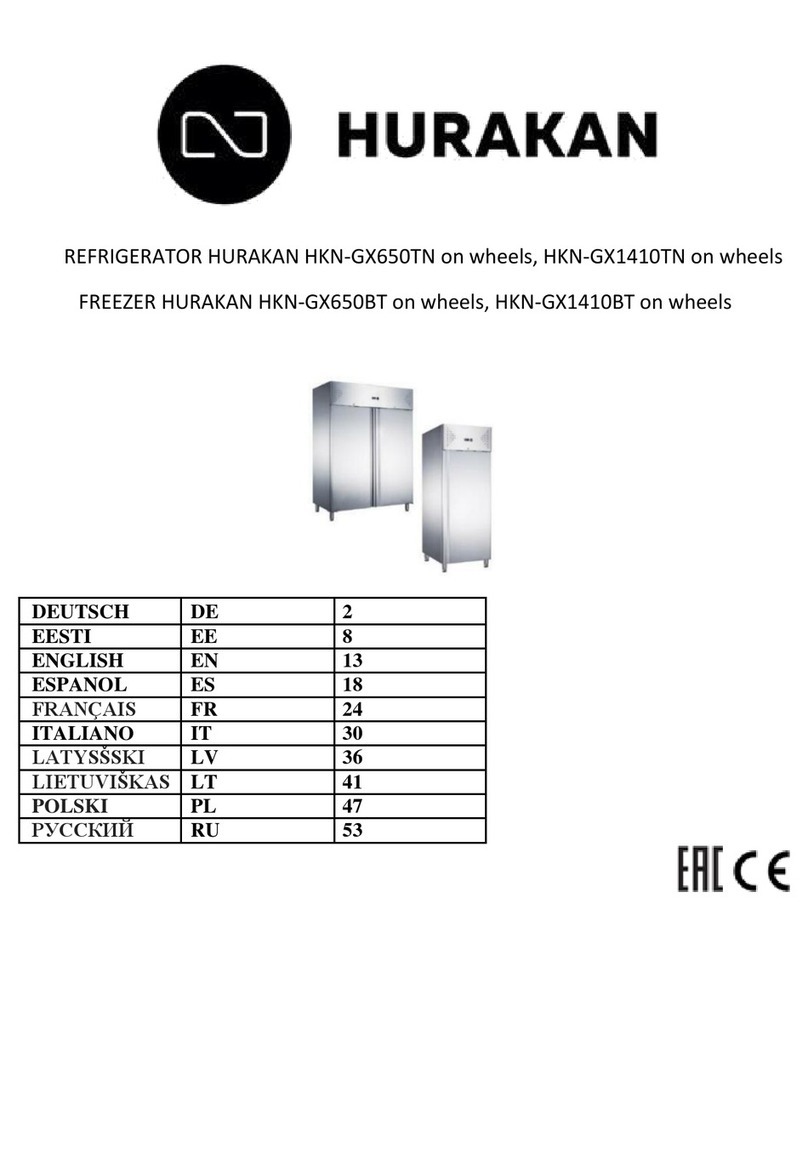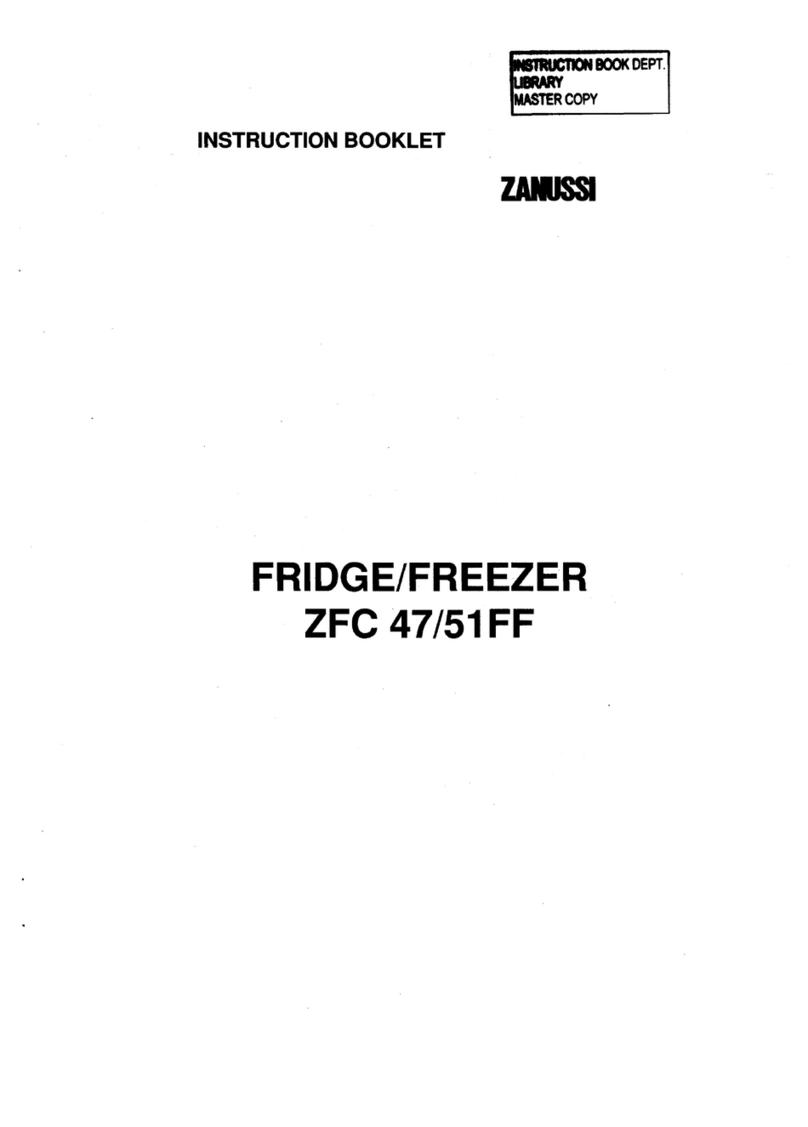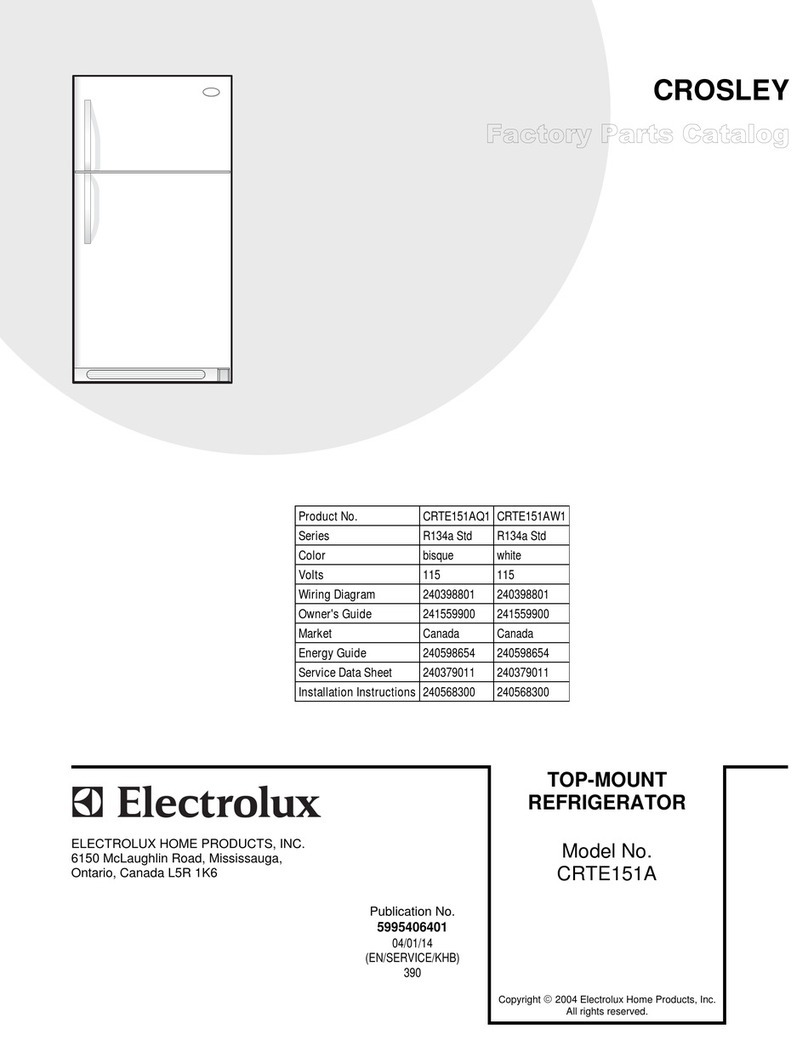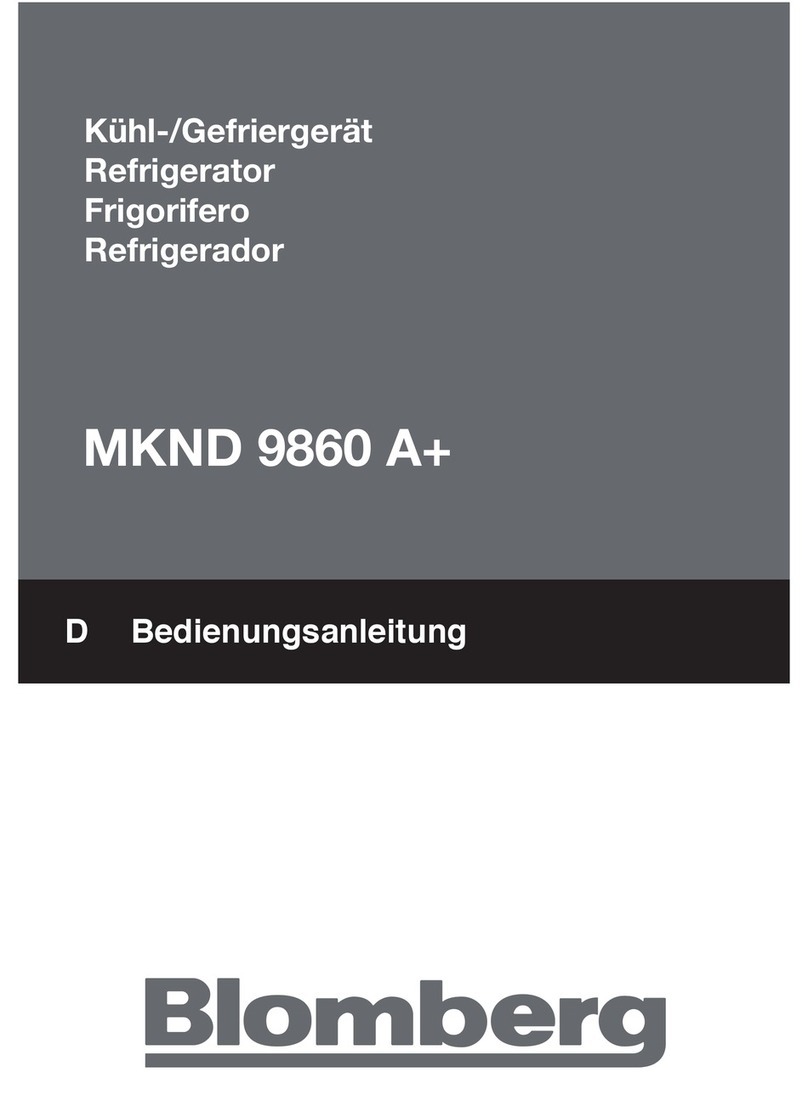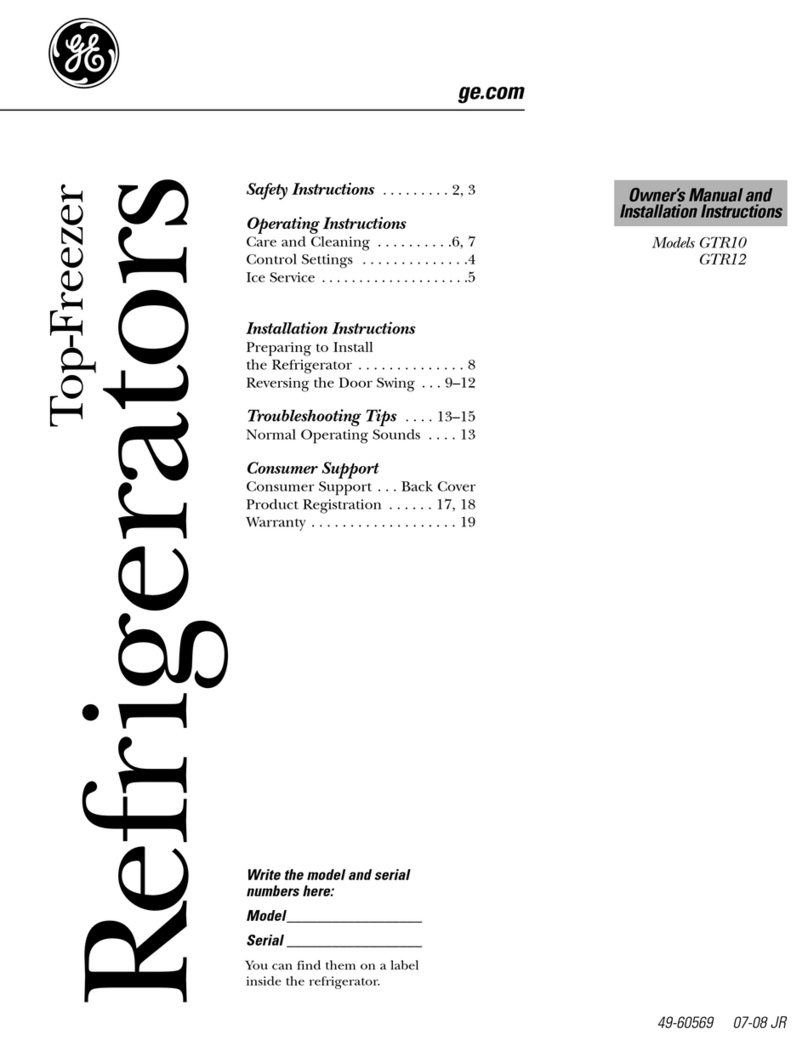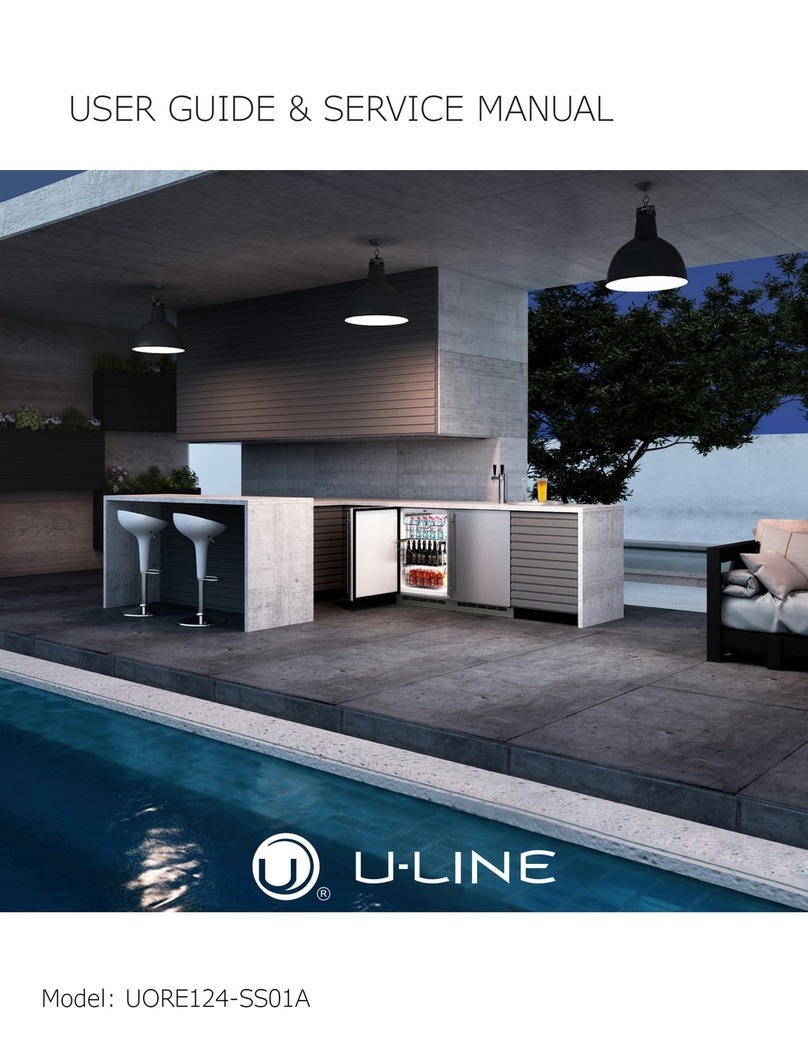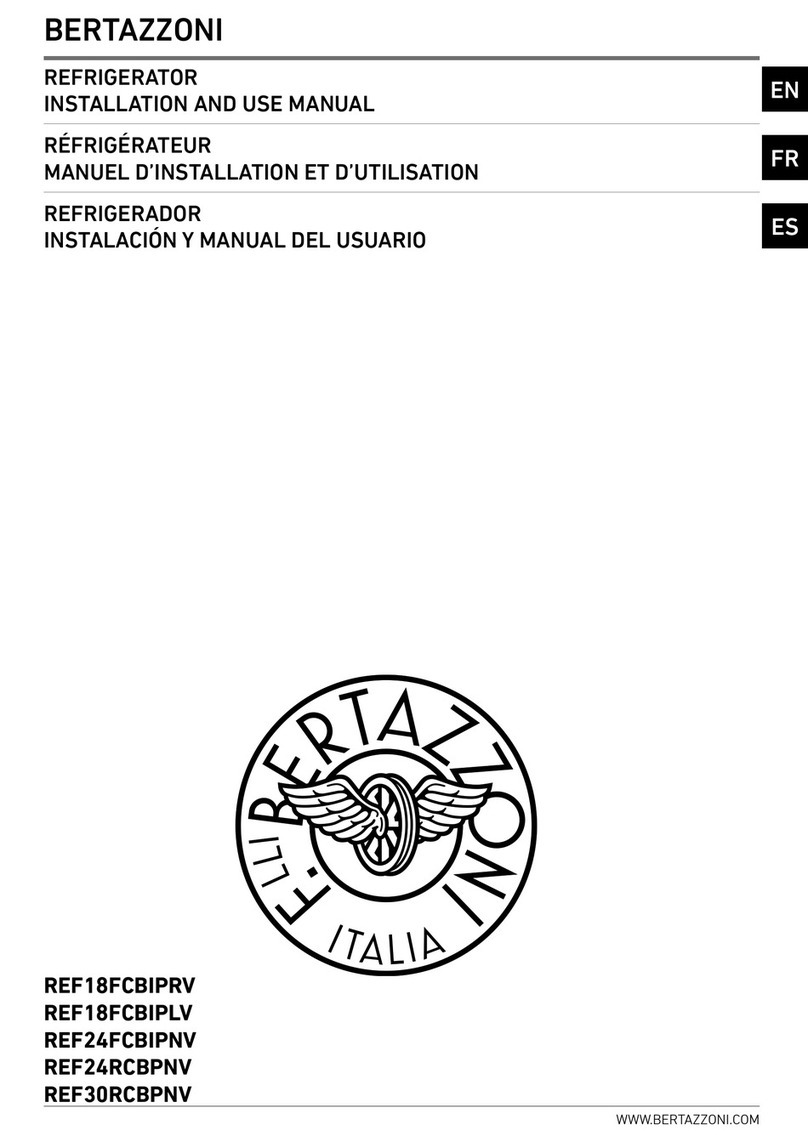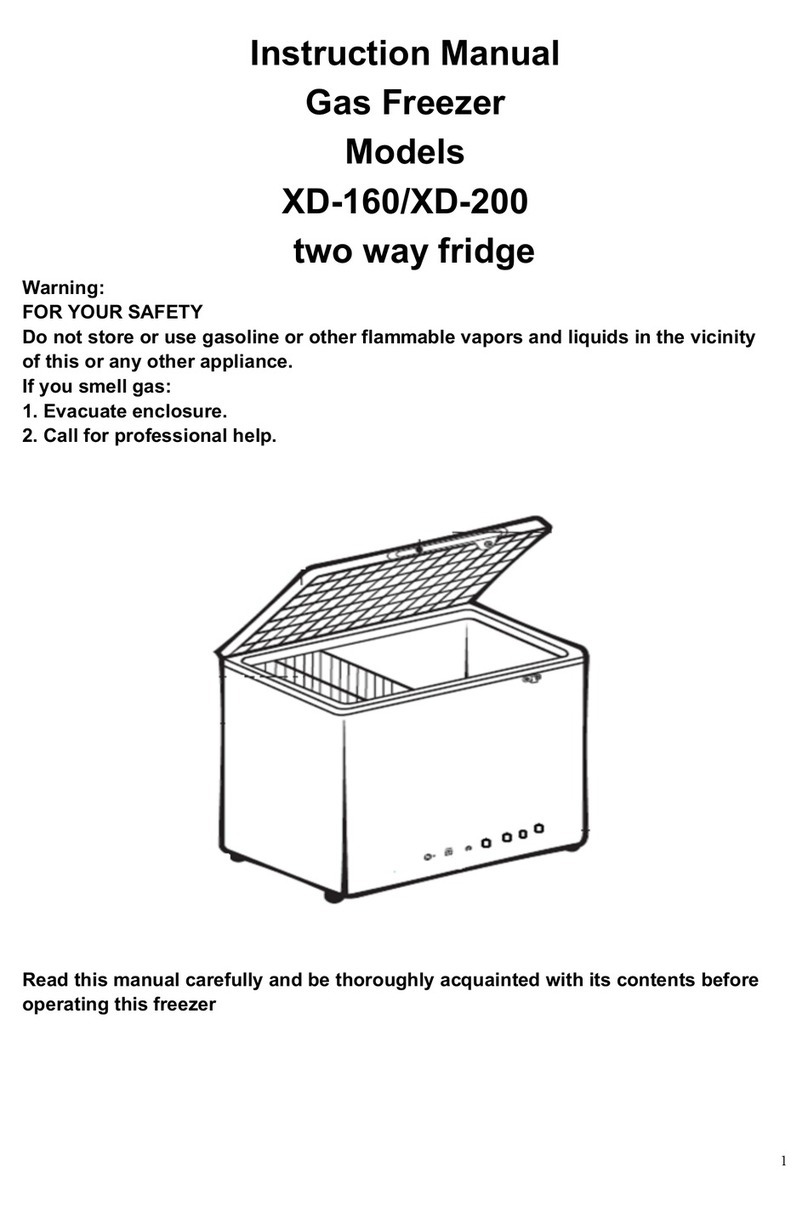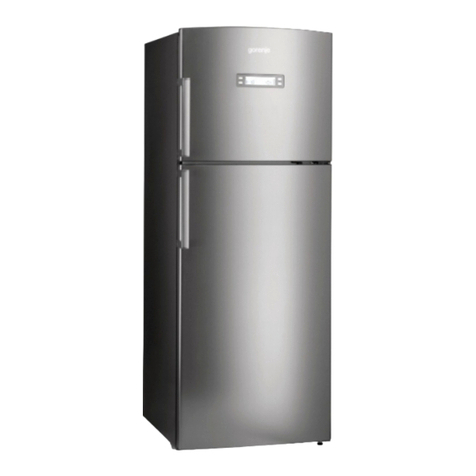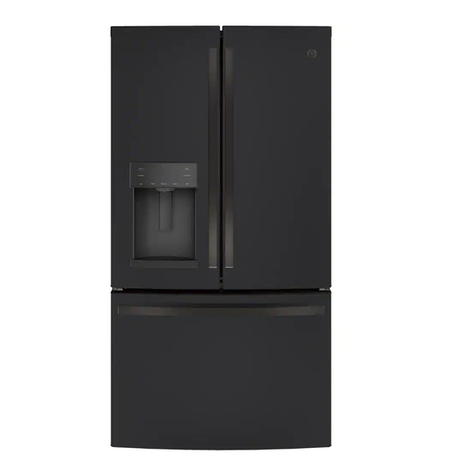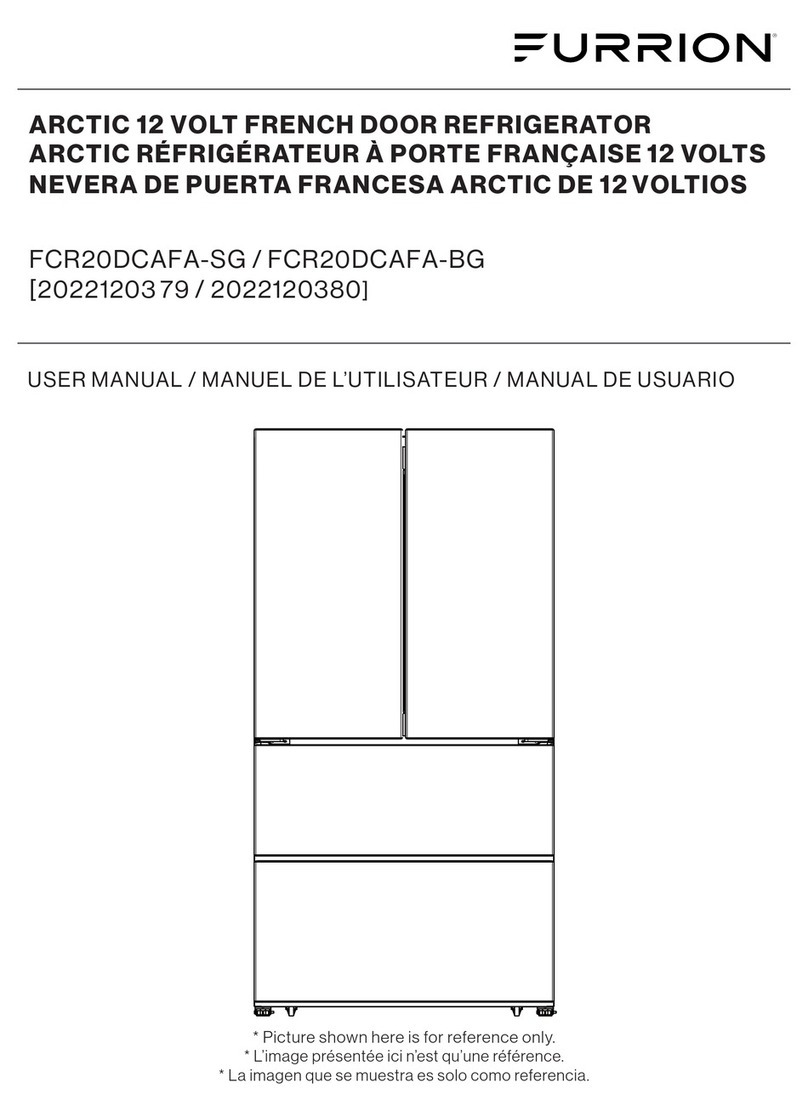Atag KS24178A User manual

Instructions for use
Built-in refrigerator
KS24178A
KD24178A

EN 2
We thank you for the confidence you have shown by purchasing our appliance which is designed
to simplify your life. To make the use of the product easier, we have supplied detailed instructions
for use, and installation instructions supplied on a separate sheet. The instructions should allow
you to learn about your new appliance as quickly as possible.
We wish you find a lot of pleasure in its use.
The appliance is intended solely for household use.
The refrigerator is intended for storing fresh food at temperatures above 0°C.
Please visit our website where you can enter your appliance model number, indicated on the
rating plate or the warranty sheet, to find detailed description of your appliance, tips on use,
troubleshooting, service information, instructions for use etc.

EN 3
TABLE OF CONTENTS
Introduction
Safety instructions 4
Advice for saving power with refrigeration appliances 10
Installation and connection 11
Appliance description
Appliance description 13
Operating the appliance 14
Appliance interior equipment 19
Recommended distribution of food in the appliance 24
Storing food
Storing food in the refrigerator 25
Defrosting and cleaning the appliance
Defrosting the appliance 26
Cleaning the appliance 27
Other
Troubleshooting 29
Information about appliance noise 31

EN 4
Before using the appliance for the first time
Before connecting the appliance to the
power mains, please read carefully the
instructions for use which describe the
appliance and its correct and safe use.
The instructions apply to several appliance
types/models; thus, settings or equipment
may be described herein which is not
available in your appliance. We recommend
saving this instruction manual for future
reference and attach it to the appliance if it
is sold in the future.
Check for any damage or irregularities on
your appliance. If you find your appliance is
damaged, notify the retailer from which you
have purchased the appliance.
Before connecting the appliance to the
power mains, let the appliance rest in a
vertical position for a minimum of 2 hours.
This will reduce the possibility of operation
faults due to the effect of transport on the
cooling system.
INTRODUCTION
Safety instructions

EN 5
Safety instructions
The appliance must be connected to the
power mains and grounded in compliance
with the effective standards and regulations.
Before cleaning the appliance, unplug it
from the power mains (unplug the power
cord from the wall outlet).
If the power cord is damaged, it must be
replaced by a service technician or other
adequately trained person.
If LED lighting does not work, call a service
technician. Do not attempt a repair of the
LED lighting yourself, as there is danger of
contact with high voltage!
WARNING! Do not use any electric
devices inside the appliance, except for
those allowed by the manufacturer of this
refrigeration appliance.
WARNING! Do not use mechanical devices
or other means to accelerate the defrosting
process, other than those recommended by
the manufacturer.
WARNING! To avoid any hazard resulting
from poor stability of the appliance, make
sure it is installed as instructed.
INTRODUCTION

EN 6
Danger of frostbite
Never put frozen food in your mouth and avoid touching
frozen food as this may cause frostnip or frostbite.
Safety of children and vulnerable persons
This appliance can be used by children aged from 8 years
and above and persons with reduced physical, sensory or
metal capabilities or lack of experience and knowledge if
they have been given supervision or instruction concerning
use of the appliance in a safe way and understand the
hazards involved.
Remove the packaging intended to protect the appliance
or particular parts during transport and keep it outside the
reach of children. It presents danger of injury or suffocation.
Store all the parts that remain out of children’s reach after
finishing the assembly of the appliance or after fitting it into
a cabinet, as they can cause choking.
Do not let the children play with the appliance.
Cleaning and user maintenance shall not be made by
children without supervision.
When removing a used appliance, disconnect the
power cord, remove the door, and leave the shelves in
the appliance. This will prevent children from locking
themselves in the appliance.
INTRODUCTION

EN 7
Warning regarding the refrigerant
The appliance contains a small amount of an
environmentally friendly yet flammable gas R600a. Make
sure that no parts of the cooling system are damaged. A
gas leak is not hazardous to the environment, but it could
cause eye injury or fire.
In case of a gas leak, ventilate the room thoroughly,
disconnect the appliance from the power mains, and call a
service technician.
INTRODUCTION

EN 8
The rating plate can be found in the
appliance interior (see figure). It indicates
data on voltage, gross and net volume, type
and amount of refrigerant, and the climate
classes.
/
//
//
The appliance may not be used outdoors and it may not be
exposed to rain.
Do not store explosive substances such as aerosol cans
with a flammable propellant in this appliance.
If the appliance will be out of use for an extended period
of time, switch it off using the relevant button, and unplug
it from the power mains. Empty the appliance, defrost it,
clean it, and leave the door ajar.
In case of an error or power supply failure, do not open the
freezer compartment unless the freezer has not operated
for over 16 hours. After this period, use the frozen food or
provide sufficient cooling (e.g. a replacement appliance).
Technical information on the appliance
INTRODUCTION
Important information on the use of appliance
WARNING! Keep ventilation openings, in
the appliance enclosure or in the built-in
structure, clear of obstruction.

EN 9
Environment protection
The packaging is made of environmentally friendly materials
that can be recycled, disposed of, or destroyed without any
hazard to the environment.
The symbol on the product or its packaging indicates that the product should not be
treated as normal household waste. The product should be taken to an authorized
collection centre for waste electric and electronic equipment processing. Correct
disposal of the product will help prevent any negative effects on the environment and health
of people which could occur in case of incorrect product removal. For detailed information on
removal and processing of the product, please contact the relevant municipal body in charge
of waste management, your waste disposal service, or the store where you bought the
product.
INTRODUCTION
Removing an obsolete appliance
To protect the environment, take the
obsolete appliance to an authorized home
appliance collection centre.
Before doing so, do the following:
• disconnect the appliance from the power
mains;
• do not allow children to play with the
appliance.
WARNING! Do not damage the refrigerant
circuit. This will also prevent pollution.

EN 10
Advice for saving power with refrigeration appliances
• Install the appliance as specified in the instruction manual.
• Do not open the door more often than necessary.
• Occasionally make sure air circulation underneath the appliance is unobstructed.
• Condenser unit on the rear wall should be kept clean (see chapter ‘Cleaning the Appliance’).
• If the gasket is damaged or does not provide a perfect seal for any reason, have it replaced
as soon as possible.
• Store the food in tightly sealed containers or appropriate packaging.
• Before placing the food in the refrigerator, allow it to cool down to room temperature.
• Defrost frozen food in the refrigerator compartment.
• Make sure the layout of shelves in the compartment is uniform and that the food is placed
so that the air can freely circulate in the appliance interior (observe the recommended
placement of food as described in the instructions).
• Do not block the fan slots or vents.
INTRODUCTION

EN 11
Do not place an appliance in a room where
temperature can drop to below 5 °C as this may
cause abnormal appliance operation or failure!
Installation and connection
Selecting the room
• Install the appliance in a dry and well ventilated room. The appliance will operate correctly if
the environment temperature is in the interval specified in the table. The appliance class is
indicated on the rating plate / label with the basic information of the appliance.
Class Temperature Relative Humidity
SN (subnormal) from +10 °C to +32 °C
≤75%
N (normal) from +16 °C to +32 °C
ST (subtropical) from +16 °C to +38 °C
T (tropical) from +16 °C to +43 °C
INTRODUCTION
• After the installation, the appliance mains plug should be accessible!
Note: Place the appliance in a sufficiently large room. There should be at least
1 m3of space per 8 grams of refrigerant. Amount of refrigerant is indicated on the rating plate in
the appliance interior.
• At the base of the kitchen unit intended for building in the integrated appliance, there should
be at least 200 cm2free space, for adequate air circulation.
On the upper part of the appliance the air is coming out, so try not to cover the opening for
the outflow air. Ignoring this caution may result in damage to the appliance.
Warning: when installing built-in appliances into a cupboard or cabinet in a side-by-side layout,
the dew prevention installation kit should also be purchased and installed. For safety reasons,
dew prevention kit may only be installed by an authorized service technician!

EN 12
INTRODUCTION
Connecting the appliance
• Connect the appliance to the power mains using the power cord.
The wall outlet should be fitted with a ground contact (safety
socket). Nominal voltage and frequency are indicated on the rating
plate/label with basic information of the appliance.
• The appliance must be connected to the power mains and
grounded in compliance with the effective standards and
regulations. The appliance will withstand short-term deviations from
the nominal voltage, but not more than +/- 6%.
Changing the door opening direction and integrating the appliance into a cabinet
The process of changing the appliance door opening and integrating the appliance into a cabinet
is described on the separate installation instructions supplied in the bag with the instruction
manual.

EN 13
APPLIANCE DESCRIPTION
Appliance description
1. Control unit
2. LED lighting
3. Fan
4. Bottle rack
5. Glass shelves
6. Upper drawer
7. Fruit and vegetable drawer with
humidity control
8. Fruit and vegetable drawer
9. Door balconies
10. Bottle balcony
1
3
5
7
2
6
8
10
9
4

EN 14
APPLIANCE DESCRIPTION
Operating the appliance
A
B
CD
A Appliance on/off, temperature settings, and extra function key
B Refrigerator compartment temperature display
The indicator for the selected temperature will be lit.
C Intensive cooling (boost) function indicator
The Csymbol will be lit when the intensive cooling function is activated.
D High temperature indicator
To set the appliance temperature or activate extra functions, press the Akey successively. When
the key is first pressed, the currently set value or function will start to flash. With each successive
press of the key, the indicator moves to the next setting. The indicator cycles through the settings
in a circular manner, from right to left. While the settings are being adjusted, the display will flash.
Three seconds after the key is released, the setting will be stored automatically and the relevant
symbol will be lit.
Switching the appliance on/off
Switching the appliance on: Press the Akey and hold it for 3 seconds.
Switching off the appliance: Again press the Akey and hold it for 3
seconds. The appliance will be off, but there is still voltage in it as it is
still connected to the power mains.

EN 15
Adjusting the temperature in the appliance
• The factory default setting is the recommended temperature of 4 °C.
• After the appliance is switched on, it may take several hours for
the set temperature to be reached. Do not place any food into the
refrigerator before the temperature drops to the selected setting.
• Adjust the temperature as desired using the Akey.
• Press the Akey (several times) until the desired temperature
indicator lights up.
• When the Akey is pressed for the first time, the currently set value
or function will start to flash. Every successive time you press the A
key, the settings indicator will move to the next setting (from right to
left, in a circular manner).
• After three seconds, the setting will stop flashing. Your setting will
be stored and the corresponding indicator will be continuously lit.
The numbers 2, 4, 6 and 8 indicate the degrees Celsius (°C) in the
appliance refrigerator compartment.
• The recommended temperature setting is +4 °C. At this
temperature, food quality and freshness are preserved longer.
• If the ambient temperature in the room where the appliance is
installed is below 16 °C, we recommend setting a temperature lower
than 4 °C.
APPLIANCE DESCRIPTION

EN 16
Intensive cooling (boost) function
• To activate the intensive cooling (boost) function, press the Akey
several times until the symbol Clights up.
• When the intensive cooling function is activated, the appliance will
operate with maximum power. During this time, operation may be
somewhat louder.
• Use this setting after switching on the appliance for the first time, before cleaning, or 24
hours before adding a large amount of food.
• If any other function is selected while the intensive cooling function is active, the intensive
cooling function will be deactivated immediately.
• To switch off the intensive cooling function, press the Akey to select the desired temperature
B. If the intensive cooling function is not deactivated manually, it will be automatically
switched off (after approximately six hours), and the temperature will return to the most
recently set value.
• If there is a power outage while the intensive cooling function is active, the function will be
restarted when power supply resumes.
APPLIANCE DESCRIPTION

EN 17
High temperature alarm
If the temperature inside the appliance is too high, acoustic alarm will
be activated (intermittent tone) and the Dsymbol will flash.
• Every time the appliance is switched on, there is a 24-hour delay
in high temperature alarm operation as it takes some time for the
appliance to reach the adequate temperature. Thus, unnecessary
activation of the alarm is prevented.
• To acknowledge and turn off the acoustic alarm, press the Akey. If
the alarm is not deactivated manually, it will be sounded for the first
five minutes of every hour.
• When you press the Akey for the first time, the alarm will be
acknowledged and turned off. When you press the A key again, it
will already work as a settings adjustment key.
• The Dsymbol flashes until the appliance reaches a suitable
temperature.
APPLIANCE DESCRIPTION

EN 18
Open door alarm
If the refrigerator door is open for more than two minutes, an acoustic
alarm (continuous beep) will be activated.
To acknowledge and turn off the acoustic alarm press the Akey or
close the door.
APPLIANCE DESCRIPTION

EN 19
APPLIANCE DESCRIPTION
Appliance interior equipment
Shelf
• Empty shelves can be distributed in the refrigerator interior without
having to remove the shelf from the refrigerator.
To move the shelf to a different height, lift it at the front, hold it at
the back, pull forward a little and move it higher or lower.
To remove the shelf from the refrigerator, first lift it at the front part,
hold it at the back part, and pull it out from the appliance.
• The bottle rack is protected against being inadvertently pulled out. It
can only be pulled out when it is empty.
• To pull it out, lift it slightly at the front and pull it towards you. Place
the bottle rack so that the length of the bottles does not prevent
proper closing of the door.
• The rack can take a maximum load of nine 0.75-litre bottles or 13
kilograms of total weight.
• Cans may also be placed on the bottle rack (lengthwise or
crosswise).
Bottle rack

EN 20
• The drawer at the bottom of the refrigerator is intended for storing fruit and vegetables. It
provides humidity and prevents the food from drying out.
• The humidity in the drawer is regulated automatically, depending on the type and amount of
inserted food.
Vegetable drawer with automatic humidity control (model KD24178A)
• Pulling out the drawer:
Pull out the drawer as far as it will go. Then, lift the front part and
pull it out completely.
• To insert the drawer, follow the reverse order.
1
2
APPLIANCE DESCRIPTION
This manual suits for next models
1
Table of contents
Other Atag Refrigerator manuals
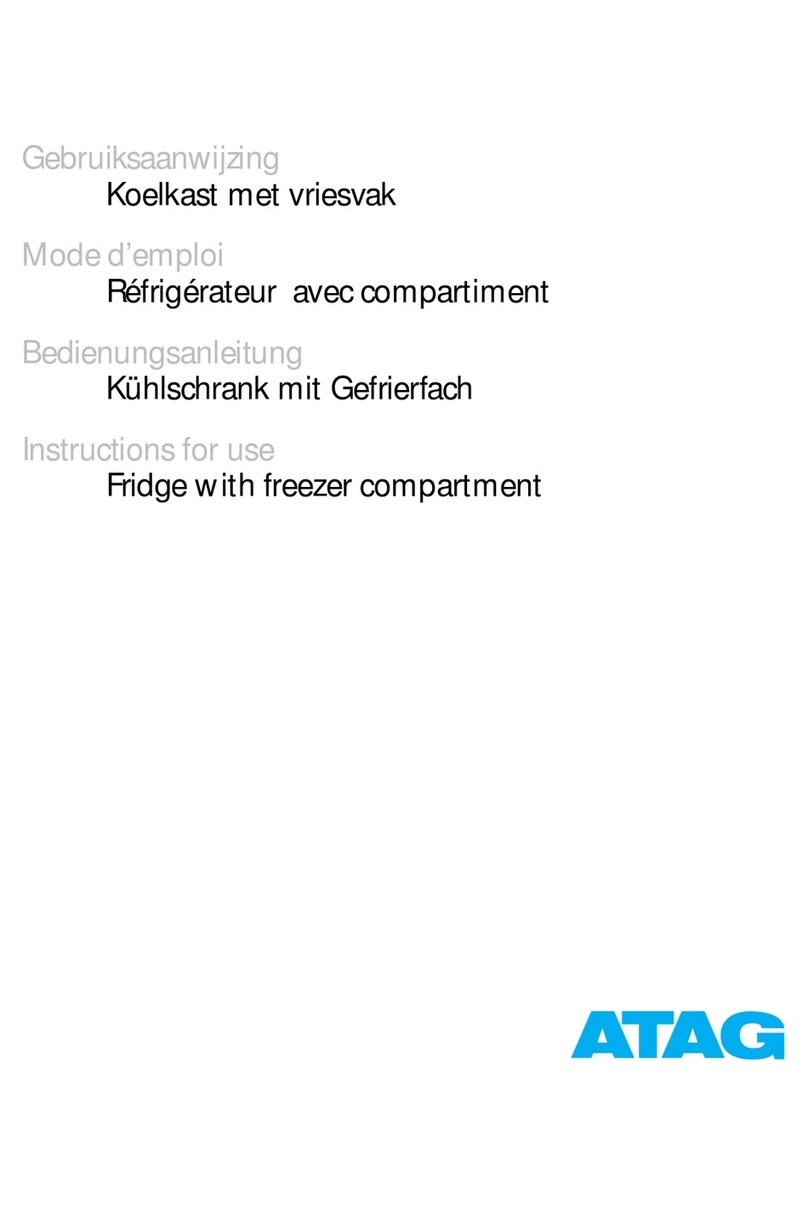
Atag
Atag KD62122A/A01 User manual
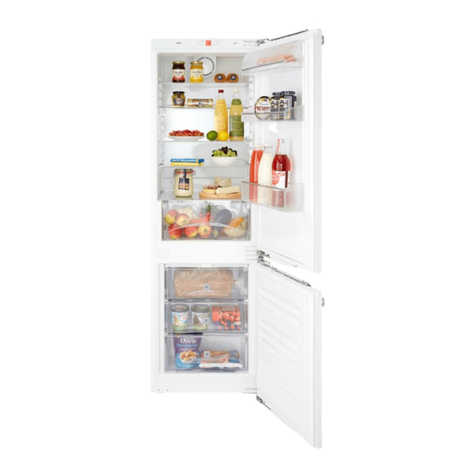
Atag
Atag KD80178BDN User manual
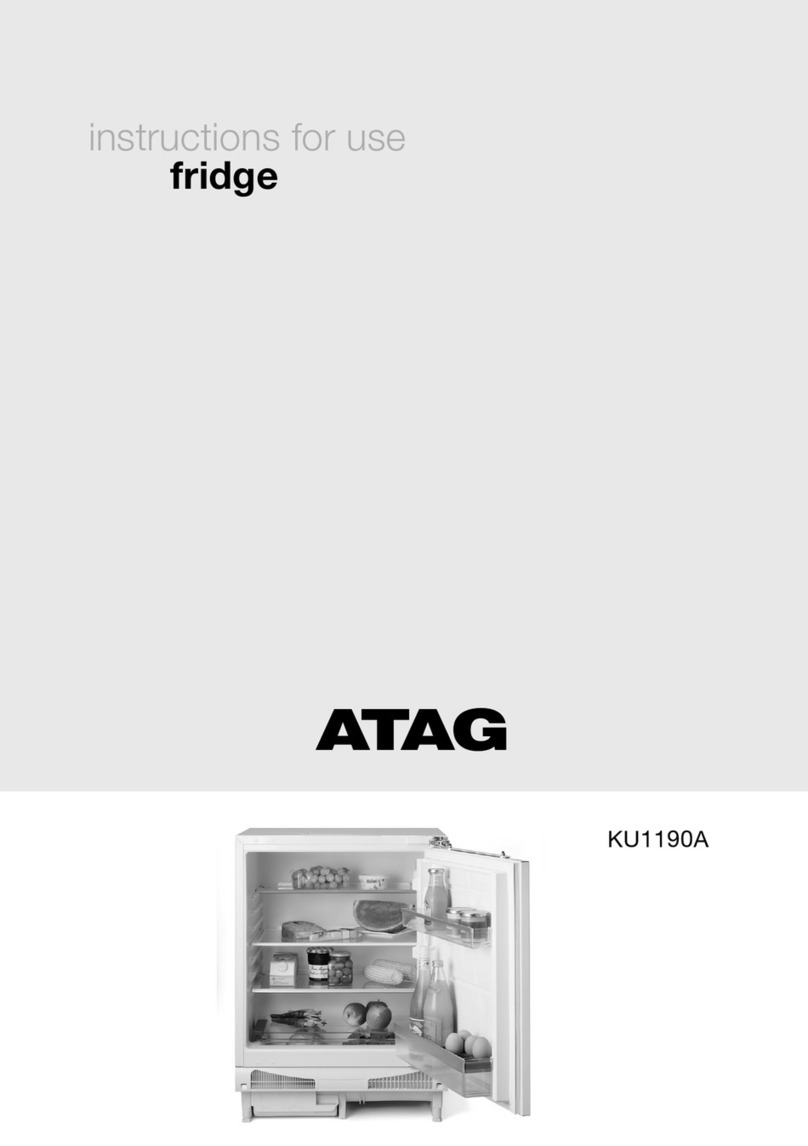
Atag
Atag KU1190A User manual
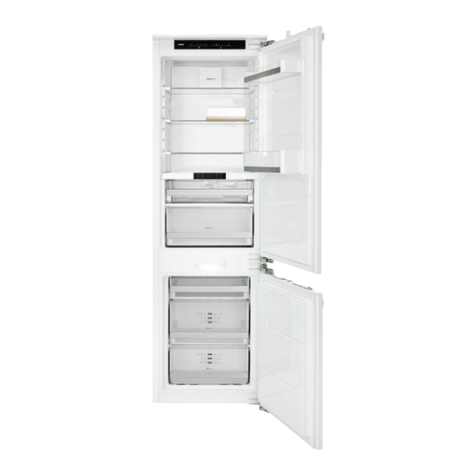
Atag
Atag KD85178BF User manual
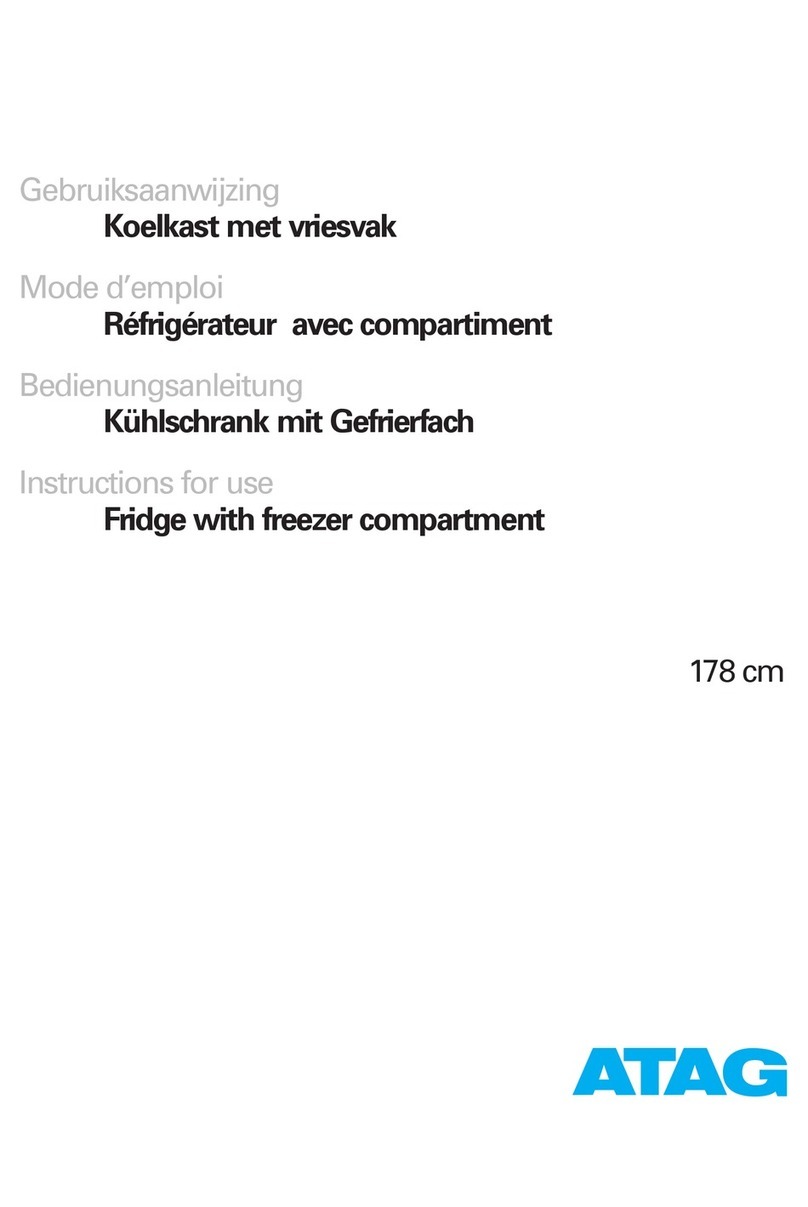
Atag
Atag KD6178BUU/A06 User manual
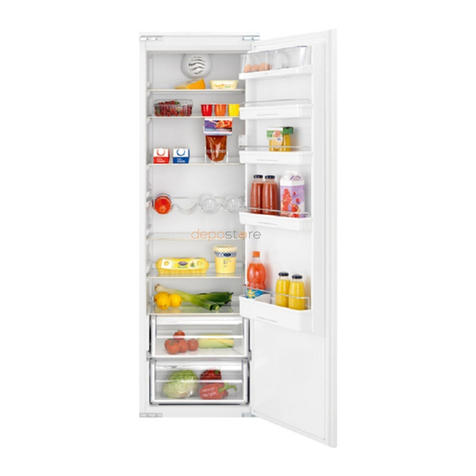
Atag
Atag KD2178A User manual
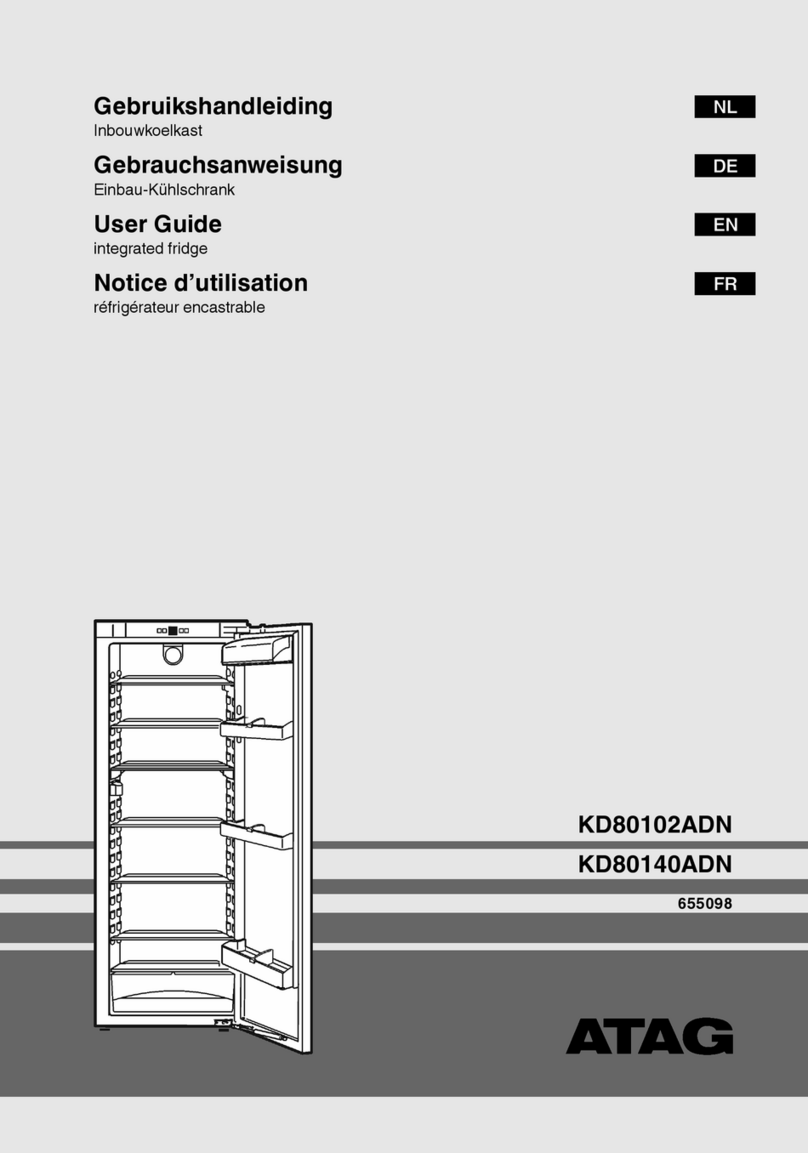
Atag
Atag KD80102ADN User manual

Atag
Atag KS33178D User manual
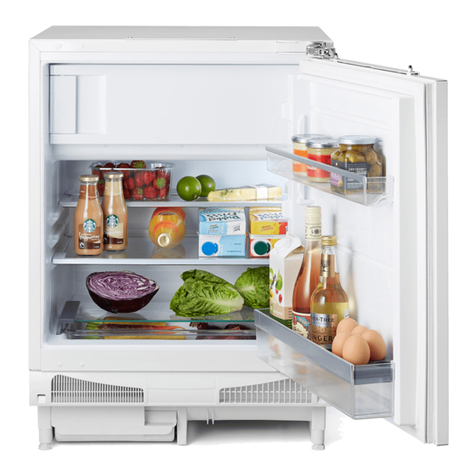
Atag
Atag KU1190B User manual
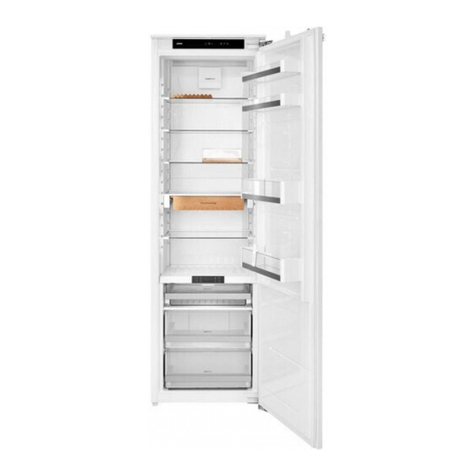
Atag
Atag KD85178AF User manual
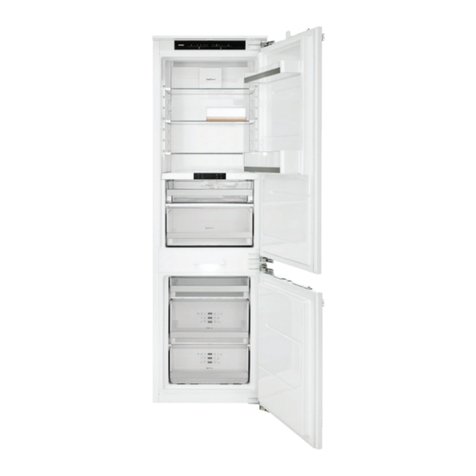
Atag
Atag KD84178BFC User manual
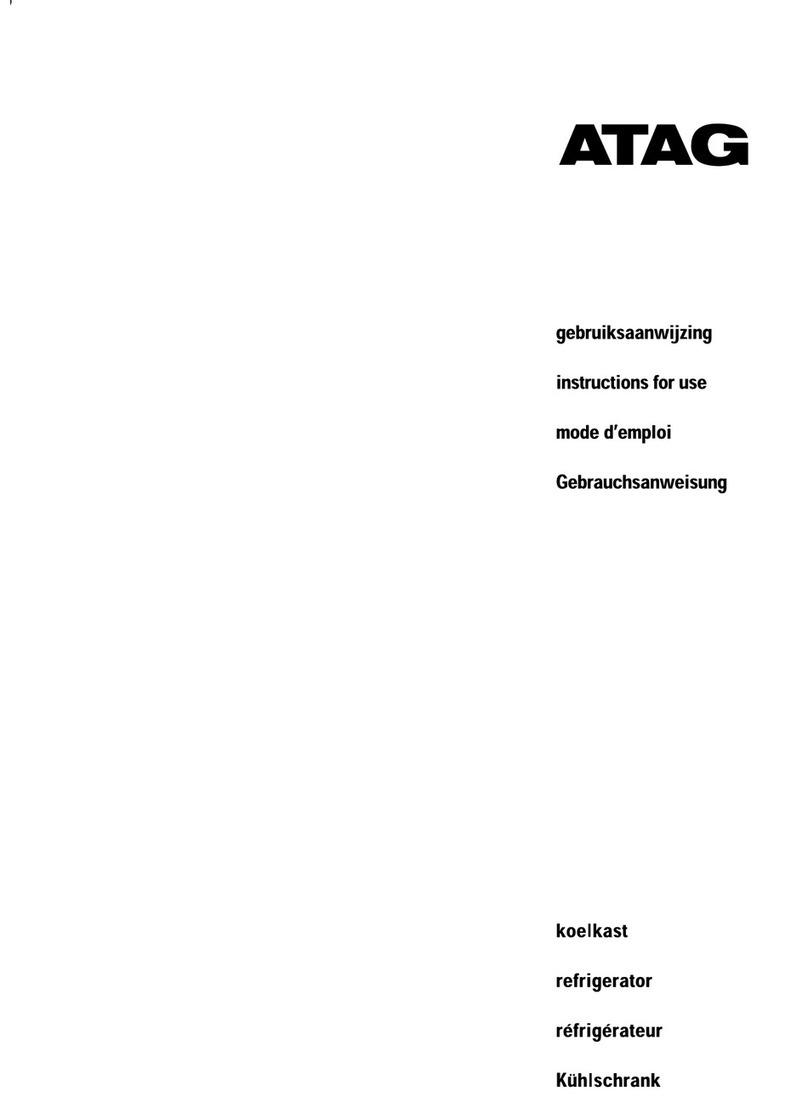
Atag
Atag KA2011LPUU/A01 User manual
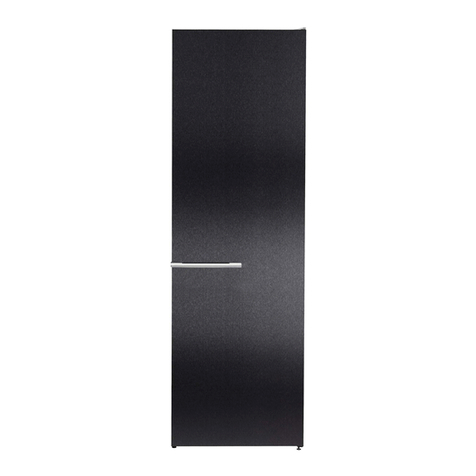
Atag
Atag KA2512AD User manual

Atag
Atag KD85102AD User manual
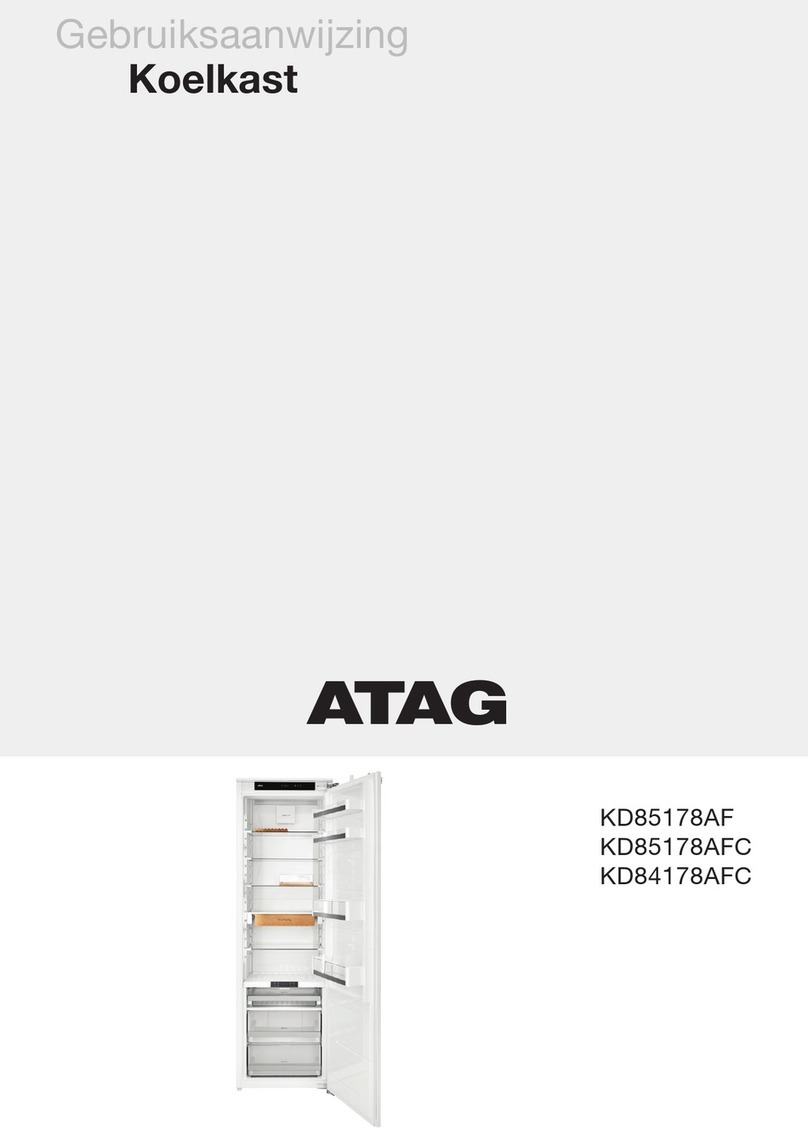
Atag
Atag KD85178AFC User manual
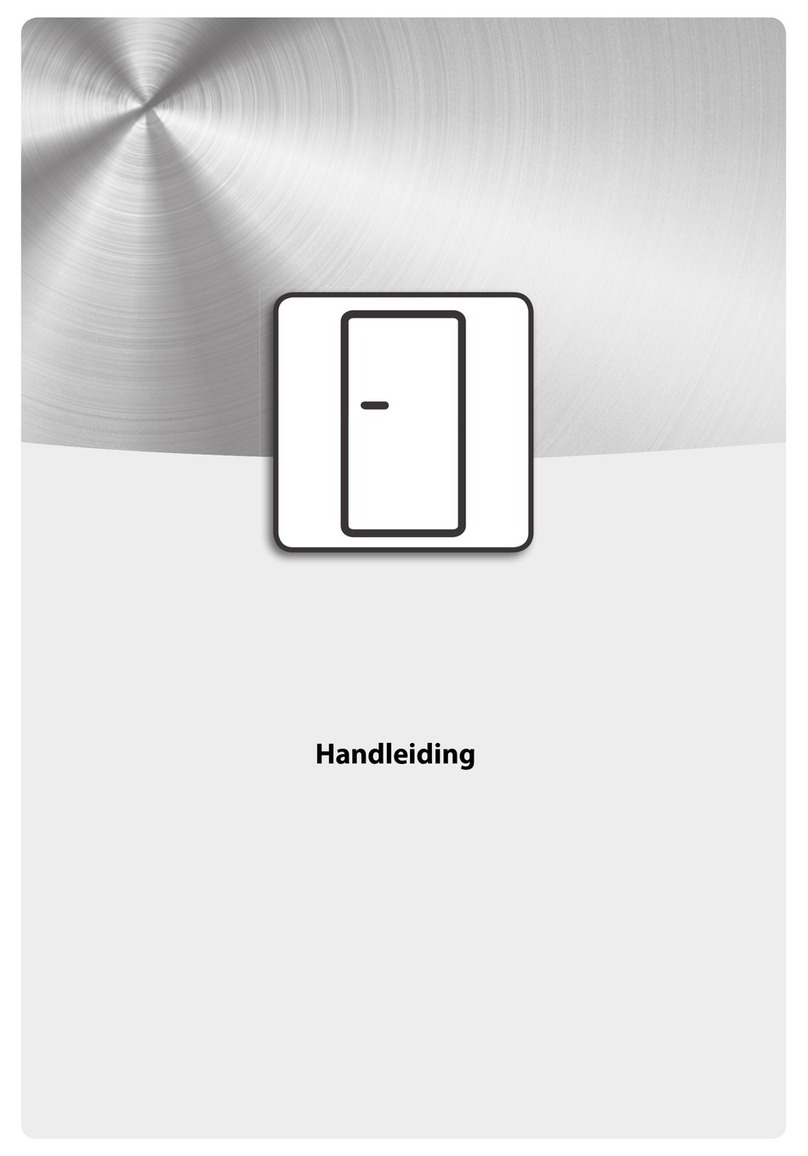
Atag
Atag KD63140B/A01 User manual
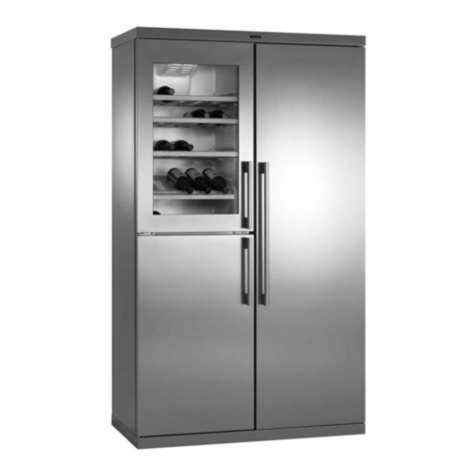
Atag
Atag KA2411R/A02 User manual
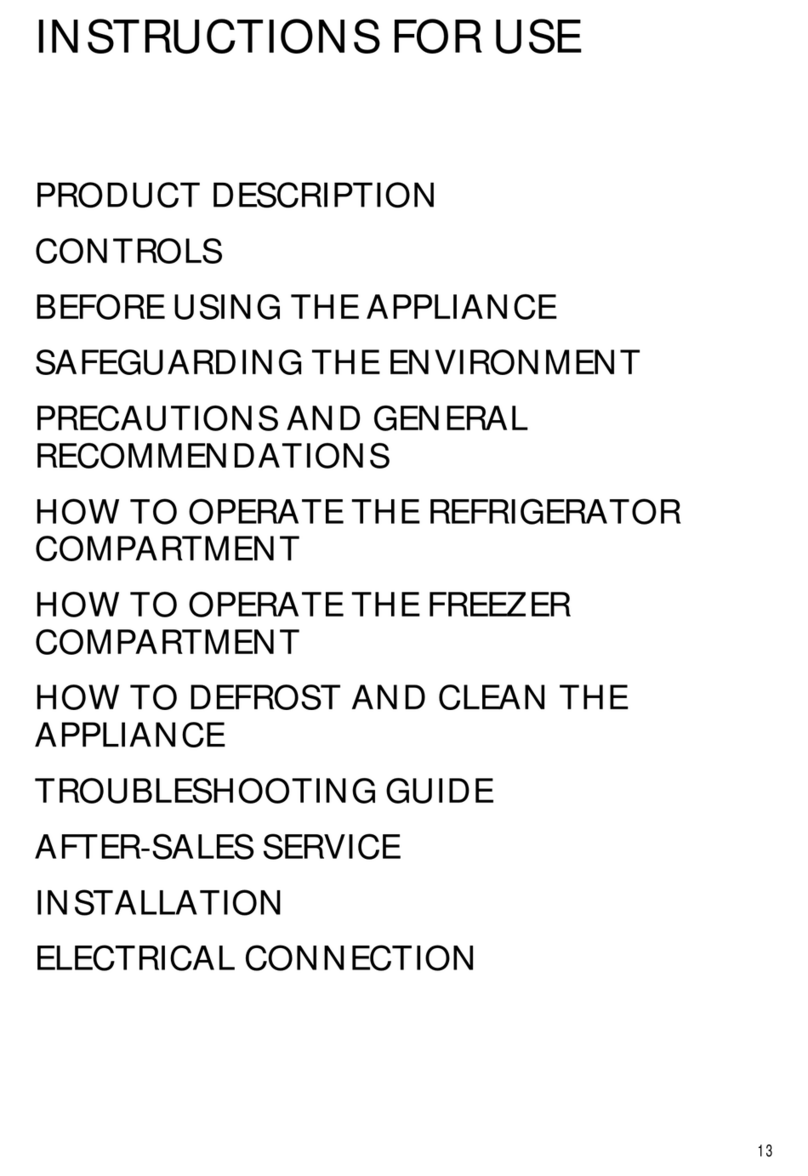
Atag
Atag KS30122BUU/A03 User manual
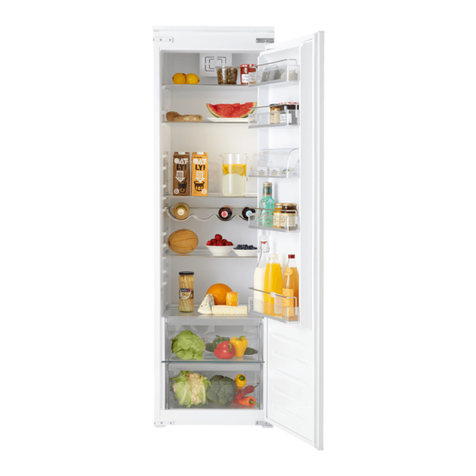
Atag
Atag KS2178A User manual
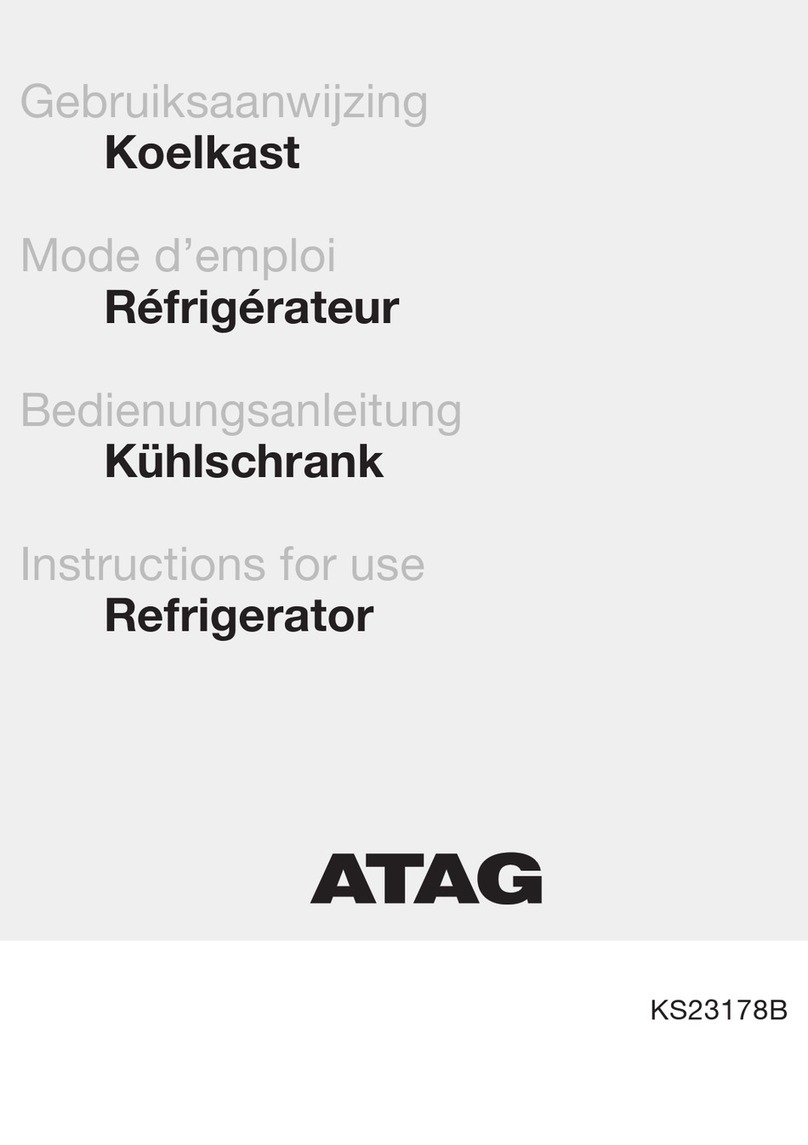
Atag
Atag KS23178B User manual
